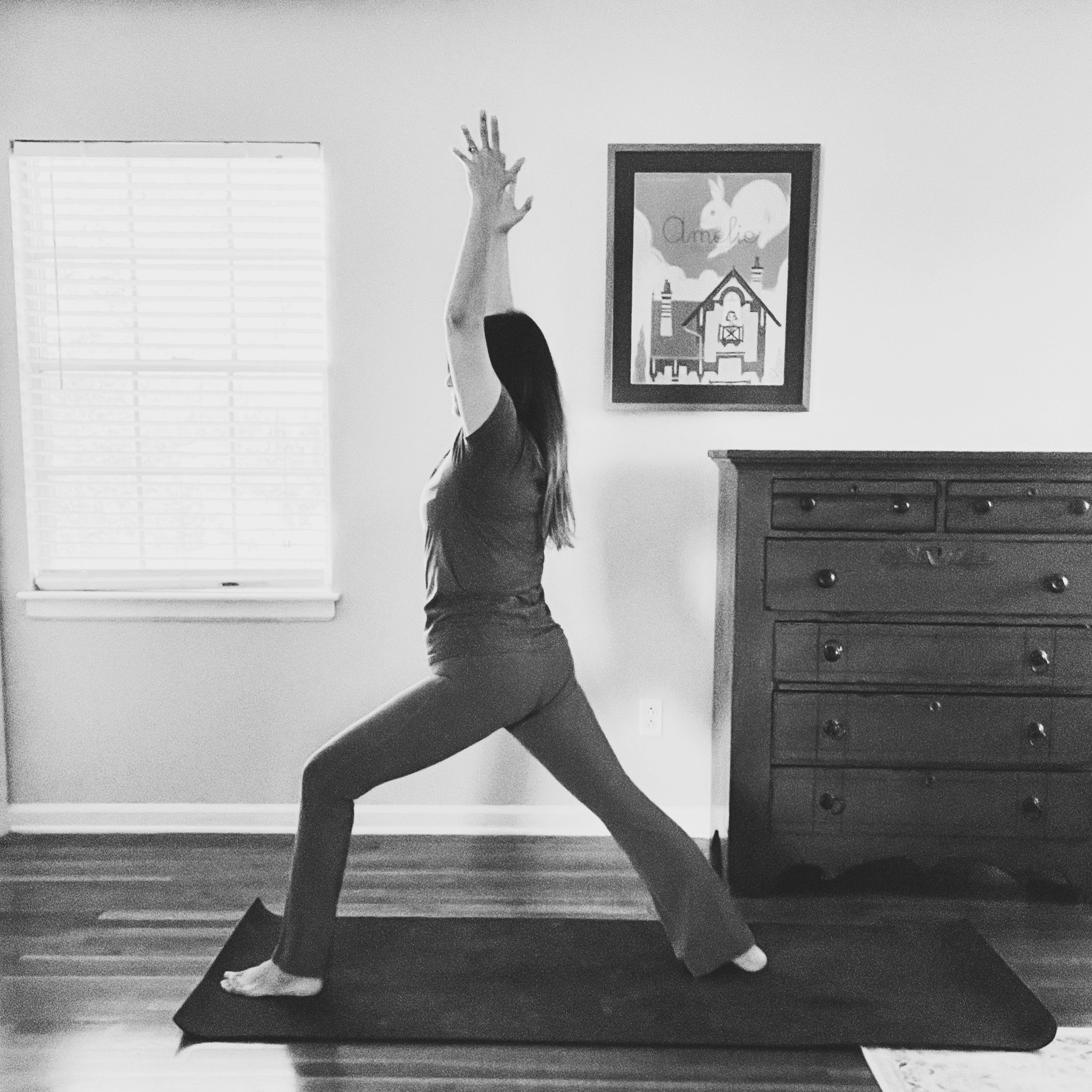Sankalpa = heartfelt desire, to become one with, intention.
Yoga Sutra 1:2
yogascittavrttinirodhah
Mastery over the roaming tendencies of the mind is yoga
By Raquel Issenberg
As I set my daily intention to calm the vrittis, the moving thoughts that clutter the mind, I take a long sigh as a reminder to detach myself from any result.
My body knows that I need more than behavioral analysis and heartfelt desires to make things happen.
This month’s local voice who enlivens the topic of yoga and the 12 Steps with her unique experience is my dear friend Ann Curry. A caring yoga teacher with a soothing voice, Ann is beloved in her community and a beam of light for many, not only among those in recovery but to her family and friends in Savannah, Georgia.
Emboding joy
“In yoga, we lie in savasana, we experience rest, peace, and surrender. In recovery, we find healing, hope, and freedom”.— Ann Curry
After her certification as Yoga for the 12 Steps of Recovery (Y12SR) instructor back in 2018, Ann began to offer this relapse prevention program to the Savannah community until the pandemic hit the world.
But Curry’s first encounter with yoga took place a while ago in St. Petersburg, Florida: “I started taking yoga classes with my brother in high school. I was drawn to what I heard and experienced in that first class. I felt better afterward. Yoga is the one thing I’ve kept up with over the years”.
Life kept taking Ann to different latitudes and, as she recounted, “when we moved back to Savannah in 2002, I joined Savannah Yoga Center (SYC) and became more involved in classes and the community”.
Countless bijas, seeds in Sanskrit, can foster our mental imprints, either to nourish us, to block us, or to afflict us.
For Curry, her deliberate intention and the joy of friendship cultivated her bija in yoga.
“I practiced for many years and watched my friend and yoga mentor, Betsy Powers, as she embarked on yoga teacher training. She planted a seed, and when I was in my mid-50s decided to take teacher training at SYC”, Ann remembered.
The Y12SR program, founded by Nikki Meyers, offers a mind-and-body approach to relapse prevention by cognizing the tools of the 12 steps through the somatic experience that yoga offers.
“Before enrolling in teacher training, SYC offered a Y12SR workshop with Nikki Meyers. Nikki’s knowledge; the gentle way she paired yoga and recovery, opened my eyes. The year I started yoga teacher training, my mother died. She lived with us for a few months before her death. I remember being so grateful for my recovery community, friends, and family. Still, it wasn't until I could take it to the mat that all those feelings began to be released—mostly the unbearable grief”, Ann narrated.
As a person starts developing coping mechanisms with helpful methods instead of harmful patterns, life perspectives start shifting as well. But since addiction is inherently related to the separation of body and mind, modern counseling standards have been progressively incorporating body awareness into talking therapy to help the individual to self-regulate as a whole.
However, the written policies of the program emphasize that Y12SR is not a substitution for substance abuse recovery, 12-Step programs, or any other related treatment: “Y12SR recognizes that yoga and its practices are part of a holistic recovery program and rather than a replacement, it provides adjunct tools to address the physical, mental and spiritual disease of addiction”.
By offering Y12SR classes, Curry’s purpose is to help others learn to feel what’s going on in their bodies as support in their recovery.
“When we decide to come into recovery, we are all experiencing forms of grief, no longer relying on substances as we slowly learn to accept life on life's terms”, she explained.
“I am grateful for my long-term recovery and the healing in the rooms and on the mat. I’m excited to embark on Y12SR on March 21st. All you need is willingness, comfortable clothes, and a yoga mat”
Frequently, yogis that also belong to 12-Step programs have found innumerable similarities between Sankhya, the philosophy of yoga, and the recovery tools that were assembled in 1935 by Bill W and Dr. Bob, the founders of Alcoholics Anonymous.
We only need to take a look at the Samadhi Pada and the Sadhana Pada, the first two books of the Yoga Sutras compiled by the sage Patanjali, to find some correlation. It is only reasonable since the study of the body, mind, and spirit is timeless.
In Sutra 2:3, for example, we observe parallels between the roots of discomfort in life and the roots of addiction: Ignorance (avidya), false sense of identity (asmita), attachment (raga), aversion (dvesa), and fear of death (abhinivesah) are the afflictions (kleshas).
Ann reflected on this aphorism by expounding that “Patanjali’s Yoga Sutra 2:3 has much to do with perception and action. We may be deceiving ourselves, and our efforts might bring harm or misfortune to ourselves and others. In the yoga sutras, avidya means ‘incorrect comprehension’, describing a false perception. It remains hidden from us, like our addiction. Kleshas are the root of our discomfort and the main Klesha is avidya.”.
When asked about her favorite pose for settling the mind, Curry simplified that “child’s pose is one of the most healing poses, wrapping your arms around yourself like a cocoon; it's safety, comfort, and surrendering to the mat.”
As Meyers underlines in her Y12SR trainings, if addictive behaviors cause disconnection from ourselves, our loved ones, and the environment, the practice of yoga can promote union, integration, and balance.
“In yoga and recovery, no experience is necessary. You come into recovery to find a better way of life, to stop living the way you're living, and become a part of it! Yoga teaches us to move and stay present and gives us grounding tools. Recovery teaches us empathy towards ourselves and others”, Curry added.
While the 12-Step programs help to treat addiction at a cognitive and behavioral level, yoga and its somatic practices teach the art of balancing our complexities in a challenging world.
About using yoga as a support for recovery and prevention of relapse, Meyers has explained in her Y12SR training that “we work with the body as we work with the steps”.
As experienced when working any 12-Step program, the Y12SR process is applied with simple practices, which Meyers has described as “we touch our mats in any posture, whatever touches the earth, is our foundation”; by engaging our connective tissue at the navel center we work with our core; and as we gain stability and ease in our postures, we work with our expression and we “set sail” in our spiritual quest.
According to Ann, assimilating yoga into her personal healing started with curiosity but also with an immense desire to serve her community and to “keep coming back”.
“I’m excited to embark on Y12SR on March 21st. All you need is willingness, comfortable clothes, and a yoga mat”, Curry finally shared.
Our intention as yoga teachers offering Y12SR classes is to combine two effective models of learning and practice, that addresses addiction as the physical, mental, and spiritual disease that it is.
What to expect
√ Y12SR is a meeting and a yoga practice. The time is divided between a 12 Step-like sharing circle and a yoga session.
√ Only foundational and simple yoga poses will be practiced at these sessions.
√ Y12SR can be done using a yoga mat or using a chair for those who are more comfortable seated.
√ Meeting topics can come from the sharing circle or the holder may suggest a reading.
√ Ann and I will alternate weeks as space holders.
⇢ On that note, Ann and I cannot wait to see you practicing with us every Tuesday! Find out more HERE.
The joy of keep coming back to the mat is when your body starts giving you the answers that sometimes your mind cannot.
Sutra 2:46
sthirasukham asanam
A stable and comfortable posture is asana.
◢ Sources:
• “The Secret of the Yoga Sutra: Samadhi Pada” and “The Practice of the Yoga Sutra: Sadhana Pada” by Pandit Rajmani Tigunait, PhD
• Y12SR






